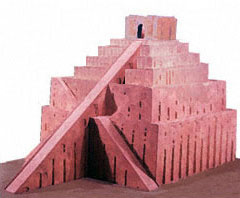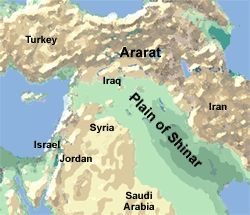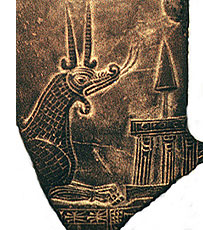|
 "There
are two ways, one of life and one of death, and there is a great
difference between the two ways." So starts the Didache, one of the
oldest extra-Biblical Christian writings, an instruction manual for new
converts. This teaching of the two ways was probably inspired by Jesus'
parable of the two ways: a narrow way that leads to life, found by
few, and a broad way, traveled by many, that leads to destruction (Matt.
7:13-14; see Jer. 21:8). "There
are two ways, one of life and one of death, and there is a great
difference between the two ways." So starts the Didache, one of the
oldest extra-Biblical Christian writings, an instruction manual for new
converts. This teaching of the two ways was probably inspired by Jesus'
parable of the two ways: a narrow way that leads to life, found by
few, and a broad way, traveled by many, that leads to destruction (Matt.
7:13-14; see Jer. 21:8).
 But the
idea of the righteous way of the few and the unrighteous way of the many
stretches back long before the time of the New Testament, into the
earliest pages of the Bible. The generations after the Flood faced a
choice of two ways: either to obey God's command to scatter and fill
the earth (Gen. 1:28; 9:1,7), or to gather many together behind the
walls of a city--the city of Babel. But the
idea of the righteous way of the few and the unrighteous way of the many
stretches back long before the time of the New Testament, into the
earliest pages of the Bible. The generations after the Flood faced a
choice of two ways: either to obey God's command to scatter and fill
the earth (Gen. 1:28; 9:1,7), or to gather many together behind the
walls of a city--the city of Babel.
  Cities do not get very positive reviews in the pages of the Tanakh
(the Hebrew Old Testament). The first city was built by Cain when he
was cast out from the presence of the Lord for the murder of his brother
(Gen. 4:17). The second was Babel with its famous tower (Gen. 11:9).* Cities do not get very positive reviews in the pages of the Tanakh
(the Hebrew Old Testament). The first city was built by Cain when he
was cast out from the presence of the Lord for the murder of his brother
(Gen. 4:17). The second was Babel with its famous tower (Gen. 11:9).*
* The cities mentioned in the genealogy of Gen. 10 were built later, after the destruction of Babel.
 An
essential characteristic of ancient cities was a city wall. If there
was no wall, it was not considered a city, only a town or village. The
first appearance of walled cities marks an important turning point in
history.* Historians consider this the beginning of civilization--a
word based on the Latin civitas ("city"). But city walls and
some of the other marks of civilization, like bronze weapons, appeared
only for the purpose of defense from the violent attacks of other
"civilized" societies. Was this really a step forward, as many assume,
or was it a giant step backward in man's moral development? An
essential characteristic of ancient cities was a city wall. If there
was no wall, it was not considered a city, only a town or village. The
first appearance of walled cities marks an important turning point in
history.* Historians consider this the beginning of civilization--a
word based on the Latin civitas ("city"). But city walls and
some of the other marks of civilization, like bronze weapons, appeared
only for the purpose of defense from the violent attacks of other
"civilized" societies. Was this really a step forward, as many assume,
or was it a giant step backward in man's moral development?
*In what archeologists identify as the Early Bronze Age.
  Both
the Bible and ancient Mesopotamian documents, as well as modern
archeology, identify the time before the advent of "civilization" as
peaceful. In Mesopotamia (ancient Iraq), this was considered a "Golden
Age" that followed the Flood, when everyone spoke the same language.
In the Bible, this matches the time before the construction of Babel,
when people slowly migrated from Ararat (ancient Armenia), where the ark
had landed, to the plain of "Shinar" (Gen. 11:2).* Both
the Bible and ancient Mesopotamian documents, as well as modern
archeology, identify the time before the advent of "civilization" as
peaceful. In Mesopotamia (ancient Iraq), this was considered a "Golden
Age" that followed the Flood, when everyone spoke the same language.
In the Bible, this matches the time before the construction of Babel,
when people slowly migrated from Ararat (ancient Armenia), where the ark
had landed, to the plain of "Shinar" (Gen. 11:2).*
* According to the Hebrew Bible,
this migration took about 250 years. According to the Old Greek (the
Septuagint) it was about 700 years. Archeologists agree that the
population moved down from the hilly highlands, though their
evolutionary assumptions lead them to a much longer period of time.
 Shinar,
which the archeologists call Sumer (the lower Euphrates river valley in
central Iraq), is where, both in the view of the Bible and modern
archeology, civilization began. The discovery of irrigation led to the
production of vast amounts of grain and a centralization of wealth,
which gave people something to be greedy about. Shinar,
which the archeologists call Sumer (the lower Euphrates river valley in
central Iraq), is where, both in the view of the Bible and modern
archeology, civilization began. The discovery of irrigation led to the
production of vast amounts of grain and a centralization of wealth,
which gave people something to be greedy about.  So the walls went up. Humanity fell away from the devotion of Noah and
his family to God. Peace was replaced by armies and war, which have
been with us ever since.
So the walls went up. Humanity fell away from the devotion of Noah and
his family to God. Peace was replaced by armies and war, which have
been with us ever since.
 The
motivation of the builders of Babel is clear: so they could avoid being
"scattered abroad over the surface of the whole earth" (Gen. 11:4).
They sought affirmation in unity, in a sense of group identity, in the
power of being many, that was directly opposite to God's calling and
God's command. The
motivation of the builders of Babel is clear: so they could avoid being
"scattered abroad over the surface of the whole earth" (Gen. 11:4).
They sought affirmation in unity, in a sense of group identity, in the
power of being many, that was directly opposite to God's calling and
God's command.
 The unity
of Babel also appealed to another of mankind's dangerous tendencies:
pride. "Let us make for ourselves a name" (Gen. 11:4), in other words,
let's make ourselves famous in the eyes of man. There's not much room
for pride in going out and scattering about the countryside, where your
neighbors are few and you're often alone with God. The unity
of Babel also appealed to another of mankind's dangerous tendencies:
pride. "Let us make for ourselves a name" (Gen. 11:4), in other words,
let's make ourselves famous in the eyes of man. There's not much room
for pride in going out and scattering about the countryside, where your
neighbors are few and you're often alone with God.
  This
pride manifested itself in a monument to their unity and their
abilities: a huge tower in the middle of the city. This tower was more
than a simple monument. It had a religious purpose, as can be seen in
the name of the city: Babel (or Babylon), from the Akkadian "Bab-illi"
which means the "Gate of God" or the "Gate of the gods."* The tower was
intended to connect heaven and earth--literally: "and its top will be
in the heavens" (Gen. 11:4). It was, in other words, a symbol of man's
attempt to reach God by his own strength and his own abilities. This
pride manifested itself in a monument to their unity and their
abilities: a huge tower in the middle of the city. This tower was more
than a simple monument. It had a religious purpose, as can be seen in
the name of the city: Babel (or Babylon), from the Akkadian "Bab-illi"
which means the "Gate of God" or the "Gate of the gods."* The tower was
intended to connect heaven and earth--literally: "and its top will be
in the heavens" (Gen. 11:4). It was, in other words, a symbol of man's
attempt to reach God by his own strength and his own abilities.
* This is the same city of Babylon
that appears later in Scripture. The decision of many translators to
use the Hebrew form of the name (Babel) in Genesis 11 and the Greek form
(Babylon) elsewhere has no basis in the original text. In Hebrew, it
is the same city with the same name.
 We
can piece together quite a bit of information about this tower because
of the many imitations built later, after people were scattered around
the world. These are the stepped pyramids (the ziggurats), the
ruins of which can still be seen in Iraq and as far away as North and
South America. The shape is that of the pyramids we all know from
Egypt, but instead of having smooth sides, they rise in a series of
stages or "steps."* The earliest pyramids in Egypt were also stepped
pyramids. The larger Indian mounds of North America and similar
structures around the world are dirt versions of this same type of
religious structure. We
can piece together quite a bit of information about this tower because
of the many imitations built later, after people were scattered around
the world. These are the stepped pyramids (the ziggurats), the
ruins of which can still be seen in Iraq and as far away as North and
South America. The shape is that of the pyramids we all know from
Egypt, but instead of having smooth sides, they rise in a series of
stages or "steps."* The earliest pyramids in Egypt were also stepped
pyramids. The larger Indian mounds of North America and similar
structures around the world are dirt versions of this same type of
religious structure.
* The circular Tower of Babel in
older illustrations is based on much later Muslim towers found by early
European adventurers in Iraq.
  Going
up the front was a huge stairway that ascended to the top, understood
to be a stairway to heaven. At the very top was a small chapel,
sometimes of a different color than the rest. Going
up the front was a huge stairway that ascended to the top, understood
to be a stairway to heaven. At the very top was a small chapel,
sometimes of a different color than the rest.
 In later
times, it was believed that the god would sometimes visit this chapel
and spend the night, or descend its stairs to other chapels built at the
base, to inhabit one of the statues of the gods there. Herodotus, in
the 5th century BC, reports the continuation in this upper chapel of one
of the same practices that brought the Flood: human women being given
as wives to these "sons of the gods" (identified in the Bible as fallen
angels, 1 Cor. 10:19,20; 2 Pet. 2:4; Gen. 6:2; Histories I.179-185).
The similar pagan use of the Tower of Babel may be indicated in Gen.
11:4 where it says the tower's "top" was in the heavens. The Hebrew
word for "top" here can also be translated "chief" or "leadership," a
possible reference to false gods. In later
times, it was believed that the god would sometimes visit this chapel
and spend the night, or descend its stairs to other chapels built at the
base, to inhabit one of the statues of the gods there. Herodotus, in
the 5th century BC, reports the continuation in this upper chapel of one
of the same practices that brought the Flood: human women being given
as wives to these "sons of the gods" (identified in the Bible as fallen
angels, 1 Cor. 10:19,20; 2 Pet. 2:4; Gen. 6:2; Histories I.179-185).
The similar pagan use of the Tower of Babel may be indicated in Gen.
11:4 where it says the tower's "top" was in the heavens. The Hebrew
word for "top" here can also be translated "chief" or "leadership," a
possible reference to false gods.
 The
religious use of these towers was, of course, based on an incredible
lie. The real God has no need of a man-made stairway to go up and down
between heaven and earth. It was a human invention that flattered man's
pride, not a heavenly necessity. This was the message of Jacob's dream
at Bethel, when he saw a visionary ladder and the angels of God going
up and down to heaven. As Jacob said after the vision ended: "This is
the gate of heaven"--there where he was, alone with God; not the
step-pyramids of the land to which he was travelling (Gen. 28:17). The
religious use of these towers was, of course, based on an incredible
lie. The real God has no need of a man-made stairway to go up and down
between heaven and earth. It was a human invention that flattered man's
pride, not a heavenly necessity. This was the message of Jacob's dream
at Bethel, when he saw a visionary ladder and the angels of God going
up and down to heaven. As Jacob said after the vision ended: "This is
the gate of heaven"--there where he was, alone with God; not the
step-pyramids of the land to which he was travelling (Gen. 28:17).
 The
step-pyramid was an important first stage in the development of the
whole system of pagan idolatry, the whole idea of localizing a god in a
single place, which gave tremendous power to the priests that controlled
it. This is still the danger of idolatry: making it seem that God
only exists in the place where the idols are; together with the related
idea that the bigger and fancier the place of worship, the more God is
present there. The truth is that God can be present equally everywhere,
not just in fancy and expensive houses of worship crowded with
worshippers. The
step-pyramid was an important first stage in the development of the
whole system of pagan idolatry, the whole idea of localizing a god in a
single place, which gave tremendous power to the priests that controlled
it. This is still the danger of idolatry: making it seem that God
only exists in the place where the idols are; together with the related
idea that the bigger and fancier the place of worship, the more God is
present there. The truth is that God can be present equally everywhere,
not just in fancy and expensive houses of worship crowded with
worshippers.
 It's
surely more than a coincidence that after the time of Constantine (4th
cent. AD), when Christianity became the passport to a better government
job, and hordes of pagans entered the Church, that the thousands of
early house churches were replaced by towering stone
structures--complete with idols--at the heart of every major city in
Europe. It might seem rude to suggest that these majestic Christian
structures shared in the spirit of Babylon. But though they are often
looked at romantically as monuments of faith, they were also associated
with increasing corruption and immorality in church leadership. The
church had become an arm of the state, with great material benefits for
those who ruled her. The greater the centralization of church
leadership, the less the accountability to the people. Bishops gave
rise to archbishops, archbishops to patriarchs; and in the West, the
papal system developed, which in the Middle Ages became one of the most
corrupt human institutions the world has ever known. The buying and
selling of church offices was standard practice across Europe. The
introduction of enforced celibacy for priests proved the moral ruin of
many. There was a flood of documented moral indiscretions--many of
which gained legal status in church law.* And the lack of religious
tolerance, which led to the execution of many tens of thousands of Jews,
Bible-believing Christians, and others, was something completely
unknown even in Babylon. Yes, unlike Babylon, these were the sins of
God's adopted people: Gentile Christians. But is God any less angry
about sin in Jerusalem than he is about sin in Babylon? It's
surely more than a coincidence that after the time of Constantine (4th
cent. AD), when Christianity became the passport to a better government
job, and hordes of pagans entered the Church, that the thousands of
early house churches were replaced by towering stone
structures--complete with idols--at the heart of every major city in
Europe. It might seem rude to suggest that these majestic Christian
structures shared in the spirit of Babylon. But though they are often
looked at romantically as monuments of faith, they were also associated
with increasing corruption and immorality in church leadership. The
church had become an arm of the state, with great material benefits for
those who ruled her. The greater the centralization of church
leadership, the less the accountability to the people. Bishops gave
rise to archbishops, archbishops to patriarchs; and in the West, the
papal system developed, which in the Middle Ages became one of the most
corrupt human institutions the world has ever known. The buying and
selling of church offices was standard practice across Europe. The
introduction of enforced celibacy for priests proved the moral ruin of
many. There was a flood of documented moral indiscretions--many of
which gained legal status in church law.* And the lack of religious
tolerance, which led to the execution of many tens of thousands of Jews,
Bible-believing Christians, and others, was something completely
unknown even in Babylon. Yes, unlike Babylon, these were the sins of
God's adopted people: Gentile Christians. But is God any less angry
about sin in Jerusalem than he is about sin in Babylon?
* Priests were taxed by the Church for their mistresses, as were brothels for their trade.
 The
Protestant Reformers fought fiercely to free themselves from this
Babylonian yoke of bondage, and to reintroduce accountability and
holiness into church leadership. But their descendants have not been
immune from the logic of Babylon. The moral rigor of the Reformation
has now reversed itself to accommodate behavior ancient pagan societies
would never have accepted.* Protestant exclusivism has been replaced
with the spirit of ecumenism. Denominations are being absorbed into
super-denominations with an increasing urgency for a vast pan-Christian
structural unity. Others, who reject this path, have found themselves
pursuing their own type of centralization in the construction of huge
mega-churches. These have been derided by their detractors as
"mini-papacies," a charge often not without a great deal of truth. From
a prophetic point of view, these developments are in harmony with the
emerging Babylonian spirit that will close out the age, and bring the
Messiah in judgment. The
Protestant Reformers fought fiercely to free themselves from this
Babylonian yoke of bondage, and to reintroduce accountability and
holiness into church leadership. But their descendants have not been
immune from the logic of Babylon. The moral rigor of the Reformation
has now reversed itself to accommodate behavior ancient pagan societies
would never have accepted.* Protestant exclusivism has been replaced
with the spirit of ecumenism. Denominations are being absorbed into
super-denominations with an increasing urgency for a vast pan-Christian
structural unity. Others, who reject this path, have found themselves
pursuing their own type of centralization in the construction of huge
mega-churches. These have been derided by their detractors as
"mini-papacies," a charge often not without a great deal of truth. From
a prophetic point of view, these developments are in harmony with the
emerging Babylonian spirit that will close out the age, and bring the
Messiah in judgment.
* The divorce rate among those who
claim to be born-again Christians in America is now higher than in the
general population, arguably at the highest level in human history.
Homosexual marriage, now gaining approval in certain denominations, has
never before had such wide acceptance in history--even in pagan
societies.
 But
the message of God has always been the opposite of the message of
Babel. Rather than centralizing worship and religious authority, God
sends his people out and scatters them across the face of the earth
(Gen. 11:8). Go!, he said to Abraham, from the big cities of Ur and
Harran to the pastures of Canaan (Gen. 12:1). Go!, he said to Moses,
from the fleshpots of Egypt (Ex. 3:10). Go!, he said to Isaiah and the
other prophets, alone, to speak my word (Isa. 6:8). Go!, Jesus said to
his disciples, and make disciples of all nations (Matt. 28:19). Go,
scatter, disperse! Whether it's down the street or around the world,
God wants us to leave our sources of pride behind and go with him to
reach the lost. Salvation does not consist in bringing people to a
"holy place" or to a "holy man" (priest, preacher, etc.), but to a holy
God who is right there where they are! But
the message of God has always been the opposite of the message of
Babel. Rather than centralizing worship and religious authority, God
sends his people out and scatters them across the face of the earth
(Gen. 11:8). Go!, he said to Abraham, from the big cities of Ur and
Harran to the pastures of Canaan (Gen. 12:1). Go!, he said to Moses,
from the fleshpots of Egypt (Ex. 3:10). Go!, he said to Isaiah and the
other prophets, alone, to speak my word (Isa. 6:8). Go!, Jesus said to
his disciples, and make disciples of all nations (Matt. 28:19). Go,
scatter, disperse! Whether it's down the street or around the world,
God wants us to leave our sources of pride behind and go with him to
reach the lost. Salvation does not consist in bringing people to a
"holy place" or to a "holy man" (priest, preacher, etc.), but to a holy
God who is right there where they are!
 We need to
purge ourselves of Babylonian thinking altogether, the human assumption
that bigger is always better. We need to stop building huge
hierarchies accountable to man and start sowing scattered worshipping
families accountable to God! Maybe working through the struggles of
faith and life in small communities of faith can bring us closer to
God--and to one another--than all the efficiencies and material
possibilities of vast organizations. Maybe true authority and
responsibility before God, rather than being a burden for the individual
believer, is important to development and growth in Christ. There are
other ways in which we can share resources and work in cooperation than
through organizational unity. Why should we want to imitate Babylonian
thinking and risk imitating her sins? The Lord tells us to scatter as
we go out to reach the lost.* We need to
purge ourselves of Babylonian thinking altogether, the human assumption
that bigger is always better. We need to stop building huge
hierarchies accountable to man and start sowing scattered worshipping
families accountable to God! Maybe working through the struggles of
faith and life in small communities of faith can bring us closer to
God--and to one another--than all the efficiencies and material
possibilities of vast organizations. Maybe true authority and
responsibility before God, rather than being a burden for the individual
believer, is important to development and growth in Christ. There are
other ways in which we can share resources and work in cooperation than
through organizational unity. Why should we want to imitate Babylonian
thinking and risk imitating her sins? The Lord tells us to scatter as
we go out to reach the lost.*
* The experience of persecuted
believers has shown that it is easier for the authorities to shut down a
few big, centralized churches than hundreds of scattered, small
churches.
 God
is not looking for crowds. He's looking for individuals who are
willing to stand out from the crowd and be in an individual relationship
of accountability to him! If you need the comforts of Babylon to feel
good about your relationship with God, something's wrong. Abraham
didn't have a big religious organization behind him. He had only his
own extended family and God. But he walked away from Babylon
(Mesopotamia) and changed the history of the world. Moses didn't have
access to any great material resources. All he had was a stick! (Ex.
4:2) But God used him to set a whole nation free from slavery! The
handful of Jesus' disciples "upset the world" when they finally obeyed
their calling and left Jerusalem to scatter across the world (Acts
17:6). God
is not looking for crowds. He's looking for individuals who are
willing to stand out from the crowd and be in an individual relationship
of accountability to him! If you need the comforts of Babylon to feel
good about your relationship with God, something's wrong. Abraham
didn't have a big religious organization behind him. He had only his
own extended family and God. But he walked away from Babylon
(Mesopotamia) and changed the history of the world. Moses didn't have
access to any great material resources. All he had was a stick! (Ex.
4:2) But God used him to set a whole nation free from slavery! The
handful of Jesus' disciples "upset the world" when they finally obeyed
their calling and left Jerusalem to scatter across the world (Acts
17:6).
 Our
calling is not to gather as many as possible behind towering church
walls, but to go out, individually and in groups, to spread the
gospel--in the pride-crushing, unglamorous job of reaching out to the
unsaved, the homeless, the poor. Start a Bible study in your office or
some other place of need. Talk to your neighbor about God. Or, better
yet, help start a worshipping community in a place no one else is
reaching. God will meet you there in ways you never imagined possible,
and give you victory over forces you never imagined you could defeat. Our
calling is not to gather as many as possible behind towering church
walls, but to go out, individually and in groups, to spread the
gospel--in the pride-crushing, unglamorous job of reaching out to the
unsaved, the homeless, the poor. Start a Bible study in your office or
some other place of need. Talk to your neighbor about God. Or, better
yet, help start a worshipping community in a place no one else is
reaching. God will meet you there in ways you never imagined possible,
and give you victory over forces you never imagined you could defeat.
 We, too, have a choice of two ways. Will we scatter with the few or remain with the many?* We, too, have a choice of two ways. Will we scatter with the few or remain with the many?*
*Ralph Winter of the U.S. Center
for World Mission has made the interesting observation, based on a
detailed analysis of church history, that whenever the church does not
scatter to do the work of God, God brings enemies to scatter her by
force among the unreached pagans (the "involuntary go" mechanism)--as
for example, in the time of the barbarian invasions of Europe in the 4th
and 5th centuries AD; and as, I would add, he did at the Tower of
Babel. See "The Kingdom Strikes Back: The Ten Epochs of Redemptive
History" in Perspectives on the World Christian Movement, William Carey Library, Pasadena, CA, 1981, pp. 137-155.
|
|
No comments:
Post a Comment